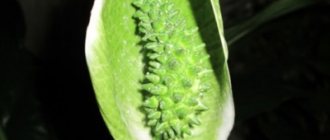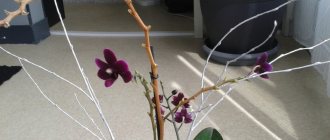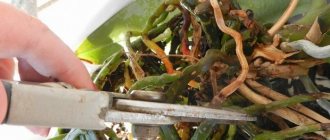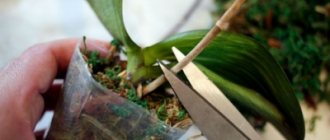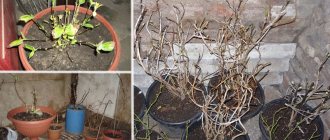The beautifully flowering plant spathiphyllum is very popular among flower lovers. He is credited with some magical properties, for which the fairer sex loves him so much. It is believed that spathiphyllum brings happiness, helps women in love and motherhood, for which it received the popular name “women’s happiness.”
The plant is unpretentious and does not require much effort when growing. It is important to know how to care for the bush during growth and flowering, as well as after the spathiphyllum fades. If the basic maintenance conditions are met, the flower will delight you for many years.
Briefly about spathiphyllum
The name "spathiphyllum" (or spathiphyllum) is derived from two Greek words: "spathe" - bedspread and "phyllon" - leaf. This is a perennial evergreen plant from the Araceae family.
The bush has no stem; its leaves grow directly from the soil. The roots are short, the leaves are long, oval or lanceolate in shape.
The inflorescence is on a peduncle, which is often confused with a stem. It consists of a cob and one petal-veil, which gave the name to the plant. The petal is white and quickly turns green after flowering.
There are about 40 species of spathiphyllum, many of them are grown at home.
If you are fond of flowers, but do not like capricious plants, the “feminine happiness” flower will suit you. What are the features of growing spathiphyllum?
Diseases and pests
Diseases are provoked by violation of the rules of care, in particular the regime of watering and lighting.
Pests that can damage it are aphids, spider mites, mealybugs and scale insects.
The spider mite leaves traces in the form of a sticky thin web; it sucks the juices from the plant, and the leaves dry out as a result.
Aphids settle on the reverse side of the leaf and also dehydrate it.
The scale leaves brown marks on the leaves.
Common pest control methods include wiping the leaves with a damp sponge to remove insects. Then you need to treat with insecticides. The main thing is to remove the diseased plant from healthy flowers in time to avoid infection.
Spraying is carried out 1-2 times a day.
It is advisable to place the flower pot on an eastern window, as diffused morning sunlight is ideal for a flower that loves bright lighting.
Little tips for gardeners:
- the room should be well lit, but avoid direct sunlight;
- the ideal temperature for the plant is +20-22 degrees;
- The flower should be watered with water that has stood for at least 24 hours at room temperature or with melt water;
- “female happiness” should be fed once or twice a month. Special fertilizers for spathiphyllum are diluted in a ratio of 1 gram per 1 liter of water.
Blooming or just faded spathiphyllum cannot be replanted, so as not to cause stress to an already weakened plant. This can only be done after a period of rest.
“Women's Happiness” does not require trimming leaves or shaping the crown. Remove or trim leaves as they age and dry out. You just need to cut off the peduncle, and we will explain in detail why later in our article.
Transplantation and propagation
Spathiphyllum does not need frequent transplants. Moreover, if the plant is regularly moved to a larger container, it stops blooming. All the energy goes into root formation and the development of a new soil mass. It is best to plan the procedure for transplanting spathiphyllum in the spring, but you can do this in winter. The main thing is that the air temperature is above 20 °C.
The first sign that the pot is becoming small is the accumulation of dried leaves in the root zone. Fresh ones grow slowly, the leaf blade becomes smaller, and the relief on it is blurred. The need to replant spathiphyllum arises in cases where the rhizome begins to protrude above the soil and the bush falls apart due to the swaying of the rosettes. This situation is favorable for propagating the plant by cuttings: one of the “seeds” can be carefully cut out and placed in water, roots will soon appear on it.
It is advisable to purchase soil for spathiphyllum in a store. This can be a universal neutral soil or a specialized mixture for aroid soils. Owners of summer cottages can easily cope with preparing the soil on their own. To do this you will need:
- 2 parts of turf land;
- 1 part leaf soil;
- 1 part of high-moor peat;
- 1 part coarse sand.
It is also useful to add a little crushed charcoal and a couple of tablespoons of ash - you will get nutritious soil with good aeration and normal acidity.
Spathiphyllum transplantation technique
Spathiphyllum roots are sensitive to damage. In order for the transplant to take place with the least loss, the plant is stopped watering for several days. A dried earthen ball comes out of the pot easier than a wet one.
After being released from the old container, the flower is placed sideways on the prepared film, the rhizome is soaked in small portions of water. This is done so that the roots of the spathiphyllum become softer and more elastic; their plexuses will be easier to untangle when dividing the rosettes. You should start with the roots at the bottom. It is convenient to straighten them with a thin, blunt object (for example, a knitting needle), while simultaneously freeing them from the old ingrown drainage. Then, using a sharp knife or hands, the rosette is carefully separated from the rhizome. If the spathiphyllum is old, then it will produce about 8-10 new bushes.
The base of each rosette must be cleared of dried and wilted leaves, and flower stalks are also cut out. This will prevent the development of fungi.
If there are no plans to propagate and rejuvenate the spathiphyllum, then the new container should be approximately 6-8 cm wider than the previous one (3-4 cm of free radius for root growth). There is no need to moisten the earthen ball, but it is necessary to clean its lower part from drainage and cut off rotten and dead roots.
A layer of 1.5-2 cm of fresh drainage is poured onto the bottom of the planting container. Old drainage should not be used without pre-treatment, as it often becomes a carrier of fungal diseases. Next, the soil is laid. If a separated rosette of spathiphyllum is planted, then the substrate is poured into a mound, the height of which, after lightly pressing down, reaches 2/3 of the pot. The roots are straightened along the radius of the mound and covered with earth, the neck of the rosette should be 2 cm below the sides of the pot.
If spathiphyllum is transplanted using the transshipment method, then 3-4 cm of soil is poured onto the drainage, then an earthen ball is installed, around which the remaining substrate is laid. If the rhizome has come out and become rough, then it is sunk and covered with soil up to the necks of the rosettes. It may be necessary to fix it for the first time: the bush is tied along the contour to prevent it from falling apart. After rooting, the support can be removed.
On the rhizome of spathiphyllum, at the base of the rosettes, you can see brown tubercles - these are aerial roots. There is no need to bury them; they will reach the soil on their own.
At the end of the replanting, the soil is spilled, and if necessary, an additional portion is added. The bush should be immediately sprayed with water. It is advisable to maintain humidity for 1-2 weeks until complete rooting.
Beginning of flowering
After the end of the dormant period, new leaves appear on the spathiphyllum, and a peduncle begins to develop in the petiole of one of them. It was this process that gave the plant its popular name: during the formation of the peduncle, the petiole thickens and becomes similar to the figure of a pregnant woman. The thickening increases in size, the green cover gradually moves apart, and the white cover of the future flower appears. After full ripening, the spathe bursts and an inflorescence appears.
Depending on the variety, the bush may produce one or more buds. Flowers continue to delight the owner from 1 month to six months.
Answers to readers' questions
Plant lifespan
Each specimen of spathiphyllum can live about 10 years. But during this time, you can (and should) separate several new plants from it, which will also serve your home for many years.
Is it possible to keep this plant at home?
It is generally accepted that spathiphyllum ennobles the atmosphere of the place where it grows. Purifies the air and saturates it with oxygen. And, of course, it pleases the eye with the beauty of the leaves and the delicacy of the flowers, which is why spathiphyllum is very common among house flowers.
Is this flower poisonous?
All plants of the Aroniaceae family are endowed with very poisonous sap. By simply touching or rubbing the leaves, no intoxication can occur, but it is better to carry out work on transplanting, pruning and propagating spathiphyllum while wearing gloves. Do not allow irritating substances to get into your eyes, and also take care of children and pets.
Why doesn't spathiphyllum bloom?
Spathiphyllum may not produce flowers for the following reasons:
- a pot that is too spacious, because in this case leaves will grow, but not flowers;
- lack of lighting or poor soil;
- too young or vice versa - too old flower.
To all this it is worth adding timely pruning of faded shoots so that they do not inhibit the formation of new ones.
Why do the leaves of a flower turn yellow (dry or wither)?
Any change in the color and turgor of the leaves is a reason to reconsider the care of the plant. This usually occurs due to excess moisture or lack of it.
Why does spathiphyllum turn black?
The most common cause of blackening of spathiphyllum leaves is rotting of the roots due to excess moisture. The cure for gray rot disease of roots and leaves is to establish a watering regime. That is, for the first time, stop watering completely and move it to a warmer place to dry. Then, having removed all diseased areas or treated them with fungicides, reconsider the water temperature, composition, and frequency of watering.
Spathiphyllum can also turn black because it will suffer from a catastrophic lack of minerals and chemicals. The way to get rid of the misfortune is to feed the spathiphyllum.
The tips of the leaves turn yellow, what should I do?
If the leaves of the spathiphyllum have turned yellow at the tips, or even turned completely yellow, then most likely the flower does not have enough moisture. This can also happen when the roots dry out, but it can also happen due to insufficient air humidity around the flower.
Dry air can be easily eliminated: spray the plant several times a day.
Sometimes, when the tips of the leaves turn yellow, you should carefully examine the spathiphyllum for infection with any pests. Then take appropriate measures to combat them.
Conditions for long flowering
All varieties of spathiphyllum bloom. If flowering does not occur during the year, then you should think about the conditions of maintenance and care.
First of all, a diseased plant will not bloom. A flower with dry leaf tips definitely requires more frequent watering and spraying. Or perhaps he is standing in a draft. Also check the temperature in the room, move the bush away from radiators so that it is not too hot and dry. If the tips of the leaves are curled, then most likely the plant is freezing. Soft yellowed leaves indicate excess moisture, dry yellow leaves indicate insufficient watering or hard water.
If the flower is visually healthy and has green, elastic leaves, then you should pay attention to proper care. Correcting possible errors contributes to long and abundant flowering:
- water for irrigation should be soft and free of impurities. Use tap water that has stood for at least 24 hours in the summer, and melt water at room temperature in the winter;
- choose a suitable pot. In a container that is too large, the flower devotes all its energy to the formation of roots rather than inflorescences;
- place the spathiphyllum in a cooler place, reduce watering, and then return it to its usual conditions. After temporary dormancy, the plant often produces flower stalks;
- Feed the bush once every two weeks, alternating organic and mineral fertilizers or using combined fertilizers for spathiphyllums.
After the inflorescences appear, the plant should be watered and sprayed more abundantly. On normal days, it is advisable to spray once a day, on hot days - twice.
Replanting the plant during flowering is strictly prohibited. It can not only lose flowers, but also die. During this period, spathiphyllum spends a lot of energy on the formation of buds, and replanting greatly weakens it.
Fading inflorescences must be removed. How and why to prune faded flowers of spathiphyllum will be discussed in detail below.
Diseases and pests
Under normal conditions, spathiphyllum rarely gets sick. Mostly, you can hear complaints from owners that it does not grow, does not bloom, and sometimes the leaves turn black and rot. The problem often lies in the soil: too acidic, flooded, affected by a fungal infection. In such cases, only transplantation with pruning of rotten roots and subsequent disinfection can improve the health of spathiphyllum.
Procedure:
- soak the earthen ball, wash off all the soil from the roots;
- dip the spathiphyllum rhizome for a few minutes in a weak solution of potassium permanganate, then dry;
- trim off all dead, blackened parts of the roots;
- Powder the large cut areas with charcoal (tablets can be used).
The new soil is impregnated with the preparations “Fitosporin-M” and “Alirin-B”, which can suppress many pathogens. If a large part of the root system is lost, the plant can be watered with the drug “Kornevin” (root formation stimulator).
If the spathiphyllum does not bloom, but its appearance is completely normal, then the issue may be the volume of the pot (too large), a lack of nutrition or banal “fatigue” of the plant. Fertilizing is carried out from late winter to autumn with complex fertilizer for home flowers.
The fertilizer consumption rate for spathiphyllum declared by the manufacturer should be halved, since this plant is very sensitive to overdose: the leaves can become covered with black or brown spots literally within a day.
Of the insect pests, spathiphyllum is usually plagued by three types.
- Thrips are small (about 2 mm) oblong insects of black or brown color. They leave traces on the leaves in the form of silvery streaks - dead cells deprived of juice. The female lays eggs in the thickness of the leaf plate, and before molting the larva hides in the ground, so several treatments of the plant will be required to completely destroy the parasites. Thrips easily adapt to chemicals; you may have to change several products. The most effective preparations are considered to be “Aktara” or “Golden Spark”, and not only the spathiphyllum itself is sprayed, but also the soil underneath it.
- Mealybug. It actively reproduces between the stems of spathiphyllums in conditions of high humidity, hanging the leaves and petioles with white cotton wool-like lumps. Initially, you can wipe the affected areas with a swab soaked in an alcohol solution. If the reproduction of the scale insect continues on the spathiphyllum, then treatment with chemicals is necessary. Such as "Aktellik", "Fitoverm".
- Spider mite. The first signs of damage are the appearance of yellow or light spots on the leaf plate. The parasite itself is rarely visible. In most cases, it is enough to wipe the spathiphyllum leaves (especially the lower part) with a soap solution. If the colony has spread throughout the plant, then treatment with Fitoverm, Vermitek or Akarin will help.
Aphids rarely attack spathiphyllums and are usually easily destroyed by washing with a soapy solution.
In some cases, small dark shells of scale insects appear on the stems and leaves of the plant. This insect can be dealt with once by wiping the affected areas with an alcohol solution and subsequent treatment with Aktara.
A disease or pest attack will be detected at an early stage if basic spathiphyllum hygiene is observed. Good drainage and dosed watering guarantee it protection from fungus. If you initially select optimal conditions for this plant, then further care will be reduced to a minimum.
Regardless of the variety, spathiphyllums decorate the room and improve the health of the air in it. Thanks to the variety of varieties, you can choose the optimal size of the bush, which, with minimal effort on the part of the owner, will delight you with delicate flowers and lush greenery.
Caring for the plant after flowering
If the spathiphyllum has faded, how to care for it further, what to do with the peduncles and leaves, can it be replanted?
After flowering, you should cut off the spathiphyllum peduncles and give it a period of rest. Caring for the plant at this time is as follows.
- reduce watering;
- feed no more than once a month;
- do not leave the plant at temperatures below 15 degrees.
Some varieties of “female happiness” can bloom all year round, so you don’t need to change their care. But the amount of fertilizing should still be reduced.
If the plant is already dormant, the petal has fallen off on its own, and the peduncle has dried out, you should not prune faded spathiphyllum flowers. Just carefully unscrew the arrow from the ground, being careful not to harm the roots.
Perhaps you are wondering whether and how to prune spathiphyllum that has faded?
Flower of female happiness (signs and superstitions)
The very first flower of this wonderful plant symbolizes the beginning of a new happy life for all household members. A pair of opened flowers means that prosperity and good luck will come in the near future.
Water the green tree more often, remove dust particles from the leaves, and talk to it regularly.
For ladies who want to find a soul mate
If a lonely housewife sympathizes with the plant, then it will increase her attractiveness and charm. The lady will regain confidence in her abilities, reveal her beauty, and become attractive to men. The flower also takes care of the health of its owner.
The plant helps women cope with the consequences of a painful breakup or death of their loved one. They cope better with difficulties and experiences. Such women have an increased chance of meeting a new chosen one again.
The flower allows men to find out the true attitude of their chosen one. To do this, you need to observe the plant. If the flower has taken root and feels quite well, then the lady of the heart loves the man, but if it has withered and withered, then the passion subsides and further relationships are in doubt.
For the family hearth
The presence of spathiphyllum in the house helps to improve the couple’s relationship, there are fewer quarrels, and the partners’ mistrust disappears. “Women’s Happiness” can be placed next to the bed where the spouses rest, which will have a positive effect on intimate relationships and reduce possible betrayals.
Material well-being
If the leaves are bright green and the plant looks well-groomed and healthy, then its owners will soon expect money increases, profit, and other pleasant moments related to money.
A sign of a deteriorating financial situation is the blackening and drying of the leaves. It is necessary to think about your spending, reconsider the distribution of the budget, and find out mistakes in the management of financial affairs in business and entrepreneurship.
To attract finance, you should bury a couple of bills in the pot. This should improve your financial situation. If the plant still dies, then within a few hours you need to bring a new one into the house. Channels for raising finance will open again. Proper care of a green tree will bring good luck and prosperity to its owner.
Does spathiphyllum need pruning?
It was previously discussed whether spathiphyllum leaves need to be trimmed. The bush has an extensive root system, and each leaf lives almost separately. Therefore, pruning of spathiphyllum leaves is not required. The exception is old, withered leaves, as well as yellowed tips of the leaves of a diseased plant. Another question is whether pruning the spathiphyllum peduncle is necessary.
After flowering, “female happiness” loses a lot of strength, the already unnecessary peduncle takes away the remaining ones. Therefore it needs to be cut off. In addition, a faded flower looks unaesthetic and spoils the appearance of an ornamental plant. In addition, pruning stimulates the growth of new shoots.
How to prune spathiphyllum correctly? It is better to do this with sharp scissors or a stationery knife. The entire arrow should be cut off, as close to the base as possible.
If the peduncle has completely dried out on its own, it should be carefully unscrewed from the rosette of leaves.
Important! Spathiphyllum is considered a poisonous plant; if it comes into contact with the skin and mucous membranes, its juice can cause irritation or an allergic reaction. If you prune the plant, it is better to use gloves.
Transfer
The plant needs replanting when the pot becomes too big for it. To do this, you need to inspect it and, if the roots come out of the drainage hole, transplant the flower into a large container. The new pot should not be too spacious. If the roots are at ease, the spathiphyllum will not bloom until the roots grow to cover the entire pot.
Transplantation is usually done in the spring. Drainage and fresh substrate are poured into the pot. The roots must be handled very carefully; if they are damaged, the flower will hurt for a long time.
After transplantation, the plant can be sprayed with water and epin.
